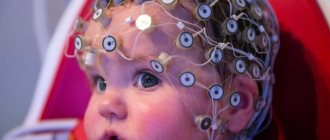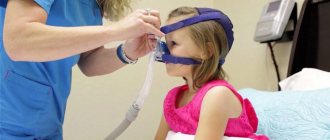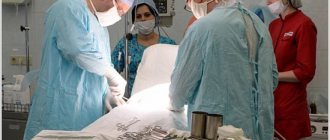Perinatal encephalopathy - symptoms and treatment
Treatment of perinatal pathology in the acute period is carried out in the neonatology department.
Surgical treatment may be necessary if the child has a large hematoma inside the cranial cavity; its removal is only possible through surgery.
With increasing closed hydrocephalus, in order to avoid brain atrophy from compression by fluid, children undergo shunt surgery - a shunt is installed (a plastic tube through which excess fluid from the cranial cavity is drained into the abdominal cavity and absorbed there).
However, most parents are faced with the need to treat a child with perinatal encephalopathy during the recovery period of up to 1 year due to impaired muscle tone, developmental delay, hypertensive-hydrocephalic syndrome and other manifestations.
The greatest effect can be achieved using an integrated treatment approach.
Therapeutic medical massage is carried out to normalize muscle tone and improve trophic processes in tissues. Should only be performed by a massage therapist with medical training and experience working with children with perinatal brain damage. The procedure is carried out in children's clinics and rehabilitation centers [3][5][7].
Exercise therapy - physical therapy. May include various types:
- Vojta therapy;
- Bobat-terpiya;
- therapeutic exercises on balls;
- mechanotherapy (exercise exercises on a simulator);
- classes with an instructor in the swimming pool.
Exercise therapy should only be carried out by an instructor with special education [6][7][18].
Microcurrent reflexology (MCRT) is a new medical technology approved by the Ministry of Health of the Russian Federation and recommended for the treatment of children with organic brain damage, delayed motor, speech, mental development and cerebral palsy. Treatment is carried out on an outpatient basis in rehabilitation centers in various regions of the Russian Federation.
The therapeutic effect is physiological and painless, using currents in the microampere range on neuroreflex zones in various areas of the skin. Microcurrents are 10 times less than with standard physiotherapy. Treatment is carried out according to an individual scheme, taking into account all the manifestations of perinatal encephalopathy present in the child.
During the treatment process, normal reflex activity of the brain is restored, muscle tone is normalized: spastic (tense) muscles are relaxed, hypotonic (weak) muscles are stimulated. MPRT stabilizes cerebral vascular tone, which allows compensation of intracranial pressure.
The method promotes the acquisition of new motor skills by restoring the activity of neurons in various areas of the cerebral cortex and cerebellum affected by hypoxia and hydrocephalus [4][6][9][14][15].
Medicines of the nootropic group (Cortexin, Pantogam, Ceraxon, etc.) should be prescribed only by a pediatric neurologist strictly according to indications, i.e., if the child has delayed psychomotor development and there are no contraindications [11][16].
diuretics only when intracranial pressure increases (expansion of the cerebrospinal fluid spaces on the NSG, the presence of clinical manifestations of hypertensive-hydrocephalic syndrome).
Pediatric neurologists, as a rule, prescribe the diuretic drug Diacarb, which also has an additional effect on the choroid plexuses of the brain - it reduces excess formation of cerebrospinal fluid and reduces intracranial pressure. However, it should be used only in combination with Asparkam, since the use of this diuretic leads to the loss of such a trace element as potassium, Asparkam replenishes its loss [16]. In mild cases in infancy, it is advisable to use gentle herbal preparations: fennel tea, dill water, approved for use in childhood.
Causes
In newborns, the pathology in question can be provoked by the following factors:
- During contractions and pushing, the umbilical cord is pinched, which affects the blood supply to the brain and other organs
- long labor
- placental abruption
- acute placental insufficiency
- asphyxia (suffocation) during childbirth
- intrauterine hypoxia
- prematurity, which causes respiratory failure in the baby
- patent ductus arteriosus
- disruption of blood flow to the heart
- congenital heart defects
- sepsis, which causes the child’s blood pressure to decrease
- heavy bleeding caused by various reasons
Pathogenesis (essence of pathology)
For the health and life of a child, oxygen is needed, which is carried through the blood to all organs and tissues of the body. If there is not enough of it, then the blood in the organs is redistributed; this is a natural regulation of the body. Blood with important oxygen begins to flow mainly to the heart and brain. At the same time, other organs experience a lack of both. If the cause of oxygen starvation is not eliminated, then asphyxia gradually develops, and the nerve cells will not be able to exist for so long. They die off. This is the essence of the process of cerebral ischemia in newborns.
It is logical that the greater the risk for a child, the larger areas of the brain that are damaged. In some children with such problems, blood spills into the brain, which can have very sad consequences.
Risk factors for pathology
On the mother's side, factors may be:
- epilepsy in a pregnant woman
- neurological pathologies in the family, in close relatives
- endocrine disorders, including thyroid dysfunction
- infertility therapy
- pathology of the placenta
- preeclampsia and eclampsia
- emergency caesarean section
- fever at the time of birth (body temperature more than 38˚ C)
- labor lasting up to 2 hours (called rapid labor in medicine)
- lack of professional medical assistance
- low birth weight
- gestation period up to 37 weeks
- The pregnancy period is more than 42 weeks.
- heavy bleeding during pregnancy and at the time of birth
But the presence of any of these reasons does not mean that the child will have hypoxia at the time of birth or after birth. They only affect how healthy the baby will be and how safe the birth will be. Many factors-causes are connected. For example, bleeding, abnormal placental function and condition, and low infant weight are associated. When they are combined, an emergency cesarean section is often prescribed or premature birth occurs. And in some cases, cerebral ischemia occurs in the newborn.
About 70 out of 100 babies with encephalopathy had developmental disorders and risk factors already when they arrived in the expectant mother’s belly. A quarter of the children also had less than healthy births. And only a small percentage of babies developed ischemia after they were born.
Degrees
- light
With mild ischemia, muscle tone increases, but not too much. Deep tendon reflexes in such children are enhanced. They suckle poorly, cry constantly, or, conversely, sleep constantly. During the first 3 days of life, manifestations of pathology are eliminated. Children who have not spent 9 months in their mother’s belly may have decreased rather than increased reflexes and muscle tone.
- average
- frequent apneas
- decreased grasping and sucking reflex
- sluggish Moro reflex
- decreased tendon reflexes
- weak muscle tone
Symptoms of moderate ischemia in newborns appear in the first 24 hours after birth. Doctors talk about a favorable prognosis if the symptoms of ischemia disappear within 14 days.
- heavy
- uncoordinated eye movements
- strabismus, nystagmus
- lack of reflexes that a newborn should normally have
- irregular breathing, such children have to be connected to a ventilator
- stupor or coma
- convulsions
- surges in blood pressure (BP)
- heart rhythm disturbances
Further observation
Patients are discharged from the hospital only after completing a full course of physical therapy and a comprehensive assessment of neuropsychic development. Most often, after discharge, patients do not require specific care, but regular examinations in the clinic are mandatory, especially for children.
If the illness was severe, the child will be observed in a special center, where he will be assisted by a neuropsychological development doctor.
Treatment for seizures depends on central nervous system symptoms and test results. They are prescribed only with a slight deviation from the norm or even within its limits. Phenobarbital is removed gradually, but it is usually taken after discharge for at least 3 months.
Diagnostics
Doctors usually find ischemia in a baby in the first few days after birth. If the degree of oxygen starvation is severe, then the child may be in a normal state for 3-4 hours or even several days, and then suddenly a very bad state occurs. Therefore, it is important to thoroughly examine the baby.
Examination of the baby . Doctors assess the patient's situation using the Apgar scale, which was discussed above. To do this, reflexes are checked, body weight and height are measured.
Analyzes:
- general blood analysis
- electrolytes
- coagulability
- gases
Magnetic resonance imaging is performed if cerebral ischemia is severe or moderate. MRI is almost never used for mild cerebral ischemia in a newborn. Using ultrasound, it is impossible to accurately determine encephalopathic processes, and it is worth considering that the result may be false positive. Ultrasound can be used to make a primary diagnosis, but other studies are required.
The current method is electroencephalography, abbreviated as EEG. Mandatory for children with severe degrees of the pathology in question. EEG makes it possible to detect hidden seizures. The method also shows how damaged the brain is and how active it can be. An EEG is also done to choose adequate treatment.
Cerebral ischemia in prematurity and in full-term infants
At term and at prematurity, the nature of brain damage is different. If a baby is not carried to term for 9 months, he or she is at risk of periventricular leukomalacia (PVL). This means that the white matter of the brain, located near the ventricles, dies and cysts form there.
PVL causes dementia and cerebral palsy in those born before the 31st week of gestation.
And for those who spent the entire period in the mother’s belly, damage mainly occurs to the cerebral cortex, that is, to the gray matter. The consequences for the child will depend on where the necrotic zone is located and how large it is. In acute and severe asphyxia (suffocation), damage to the brain stem is likely. Therefore, the child will have problems with heartbeat and breathing, which in some cases causes death, that is, death.











